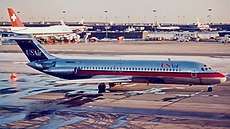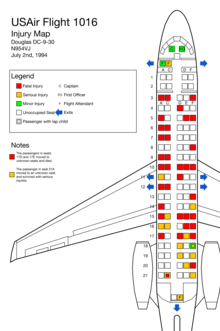USAir Flight 1016
USAir Flight 1016 was a regularly scheduled flight in the southeastern United States, between Columbia, South Carolina, and Charlotte, North Carolina.[1]:1 On July 2, 1994, the flight encountered heavy thunderstorms and microburst-induced windshear while attempting to land, and crashed into heavy trees and a private residence near the airport.[2][3][4][5] The crash and ensuing fire caused 37 fatalities and seriously injured sixteen others.[1]:1
 N954VJ, the aircraft involved, after pushback at Washington Dulles airport in 1993 | |
| Accident | |
|---|---|
| Date | July 2, 1994 |
| Summary | Microburst induced windshear leading to Pilot error and spatial disorientation[1] |
| Site | near Charlotte/Douglas Airport, Charlotte, North Carolina, United States 35°13′3.87″N 80°57′33.57″W |
| Aircraft | |
| Aircraft type | McDonnell Douglas DC-9-31 |
| Operator | USAir |
| Registration | N954VJ |
| Flight origin | Columbia Metropolitan Airport |
| Destination | Charlotte/Douglas Airport |
| Occupants | 57 |
| Passengers | 52 |
| Crew | 5 |
| Fatalities | 37[1] |
| Injuries | 20[1] |
| Survivors | 20 |
Flight
History of the flight
On Saturday, July 2, 1994, the plane, a McDonnell Douglas DC-9 registered N954VJ, departed Columbia Metropolitan Airport at 18:15 EDT for the 35-minute flight to Charlotte/Douglas International Airport with Captain Michael (Mike) Greenlee, age 38, First Officer James (Phil) Hayes, age 41.[lower-alpha 1] three flight attendants, and 52 passengers (including two infants) on board.[1]:1 The flight was uneventful until the approach to Charlotte, where several severe thunderstorms were in the vicinity of the airport. At 18:38, Flight 1016 was cleared by Charlotte approach control for an instrument landing system (ILS) approach to Douglas Airport's runway 18R (now 18C).[1]:3 The plane, flown by first officer Hayes, approached the runway in heavy rain conditions. The flight switched over to the local tower controller handling landings for runway 18R, and at 18:39, the tower controller gave Flight 1016 clearance to land. Captain Greenlee asked the tower controller for a weather report from the plane ahead of Flight 1016, a Fokker 100 that had just landed on runway 18R.[1]:4 The tower told Flight 1016 that the Fokker pilot reported "smooth sailing."[1]:4 In post-crash interviews, multiple passengers and flight attendants told the NTSB that the flight seemed normal until the plane entered a storm with heavy rain while on final approach.[1]:7
At 18:40, a tower controller issued a windshear warning to all aircraft, but on a different radio frequency than that used by Flight 1016.[1]:5 About a minute later, as Flight 1016 was on final approach, the captain, realizing that his aircraft was in a serious predicament, attempted to abort the landing by instructing the first officer to "take it around, go to the right".[1]:6 The captain then radioed the control tower and stated "USAir ten sixteen's on the go"; the tower acknowledged the missed approach and cleared Flight 1016 to climb to 3,000 feet (910 m).[1]:6 The plane struggled to climb due to the severe weather conditions, veered to the right and rapidly descended.[1]:6 The flight crew desperately tried to control the airplane as it plummeted toward the ground.[1]:6 It was later determined that the wind shear alert system did not alert them with a red indicator and aural warning because of a software discrepancy that lowered the sensitivity while the flaps were in transit from 40 degrees to 15 degrees during the go around procedure. A Honeywell engineer stated that the pilots should have received a warning 8–9 seconds before impact.[1]:12

Crash
.jpg)
of the crash's remains
At 18:42 EDT, the DC-9 touched down in a field within the airport boundary, about 0.5 miles (0.8 km) from the threshold of runway 18R.[1]:33 It then crashed through the airport fence and impacted several trees, breaking apart while skidding down a residential street that was on the airport boundary. The plane broke into four major sections; the front 40 feet (12 m) of the airplane, including the cockpit and the unoccupied first class passenger cabin, came to rest in the middle of Wallace Neel Road. The rear section of the fuselage, including the tail and the rear-mounted engines, came to rest in the carport of a house.
.jpg)
of multiple tree strikes
Of the 52 passengers on board, 37 died due to blunt force trauma, burns from the fire, or carbon monoxide inhalation. An additional 14 passengers suffered serious injuries, and one had minor injuries.[1]:37–38 Of the five crew members, both pilots suffered minor injuries, two flight attendants were seriously injured and the remaining flight attendant sustained minor injuries. No one on the ground was injured.[1]:8
The airport's previous major incident was twenty years earlier, Eastern Air Lines Flight 212, also a DC-9, in September 1974.
Investigation and response
The NTSB immediately dispatched an investigation team, which recovered the CVR and FDR from the plane's wreckage.[1]:33 After a lengthy investigation by the NTSB, it was concluded that a microburst had been generated by the thunderstorm that was over the airport at the time of the crash. The NTSB listed these contributing factors:
- The flight crew's decision to continue an approach to an area where a microburst was likely.
- The failure of the flight crew to recognize wind shear quickly (exacerbated by an error in the wind shear alert software; the wind shear alert system should have warned them about 8–9 seconds prior to impact)[1]:12
- The failure of the flight crew to establish proper pitch and engine power that would have brought them out of the wind shear
- The lack of timely weather information by air traffic control to the crew of Flight 1016
In the media
The Flight 1016 crash is discussed in a Mayday (Air Disasters in the U.S.) television series episode, "Racing the Storm" (S1E2), about American Airlines Flight 1420, which also crashed while landing in inclement weather.[6] The accident was later featured in Mayday episode "Storming Out" (S17E6).[7][8] Flight 1016 was also the subject of an episode of The Unexplained, a Biography Channel series.[9]
See also
Notes
- Captain Greenlee had 8,065 flight hours, including 1,970 hours on the DC-9. First officer Hayes had 12,980 flight hours, including 3,180 hours on the DC-9.[1]:8–10
References
![]()
- Aircraft Accident Report, Flight Into Terrain During Missed Approach, USAir Flight 1016, DC-9-31, N954VJ, Charlotte/Douglas International Airport, Charlotte, North Carolina, July 2, 1994 (PDF). National Transportation Safety Board. April 4, 1995. AAR-95-03. Retrieved December 23, 2017.
- "USAir jet crashes in Charlotte". Sunday Star-News. (Wilmington, North Carolina). Knight-Ridder-Tribune News Service. July 3, 1994. p. 1A.
- Nowell, Paul (July 3, 1994). "Jet crash claims 18 lives". Eugene Register-Guard. (Oregon). Associated Press. p. 1A.
- Nowell, Paul (July 4, 1994). "Crash followed wind shear alert". Eugene Register-Guard. (Oregon). Associated Press. p. 3A.
- "Death toll at 37 in USAir crash". Wilmington Morning Star. (North Carolina). Knight-Ridder-Tribune News Service. July 4, 1994. p. 1A.
- "Racing the Storm". Mayday. Season 1. Episode 2. 2003.
- "Storming Out". Mayday. Season 17. Episode 6. 2017.
- "Air Disasters: Storming Out". Smithsonian Channel. Retrieved March 23, 2019.
- "Death Cheaters". The Unexplained. 1999.
